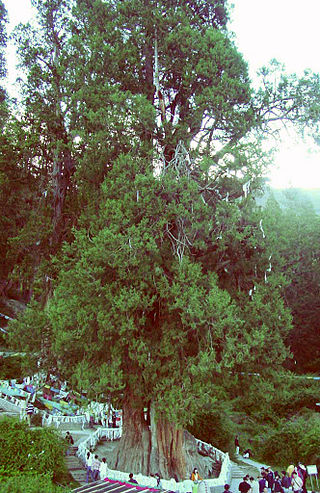
The giant pangolin is a species of pangolins from genus Smutsia of subfamily Smutsiinae within the family Manidae. It is the largest living species of pangolins. Members of the species inhabit Africa with a range stretching along the equator from West Africa to Uganda. It subsists almost entirely on ants and termites.

The Blephariceridae, commonly known as net-winged midges, are a nematoceran family in the order Diptera. The adults resemble crane flies except with a projecting anal angle in the wings, and different head shape, absence of the V on the mesonotum, and more laterally outstretched, forward-facing legs. They are uncommon, but dozens of genera occur worldwide, and over 200 species.

Aldabrachelys is genus of giant tortoises, including the Aldabra giant tortoise native to the Seychelles, as well as two extinct species, Aldabrachelys abrupta and Aldabrachelys grandidieri known from Madagascar.

Cupressus gigantea, the Tibetan cypress, is a species of conifer in the family Cupressaceae in Asia. C. gigantea was previously classified as a subspecies of Cupressus torulosa because of their similar morphological characteristics and close distribution, but have since been genetically distinguished as separate species.
Paracles is a genus of moths in the subfamily Arctiinae. The genus was described by Francis Walker in 1855. The species range from Panama to Patagonia, with quite a few in the southern temperate region of South America.
Voliba is a genus of moths of the family Crambidae described by Walker in 1866.

Solidago gigantea is a North American plant species in the family Asteraceae. Its common names include tall goldenrod and giant goldenrod, among others.

Arundinaria gigantea is a species of bamboo known as giant cane, river cane, and giant river cane. It is endemic to the south-central and southeastern United States as far west as Oklahoma and Texas and as far north as New York. Giant river cane was economically and culturally important to indigenous people, with uses including as a vegetable and materials for construction and craft production. Arundinaria gigantea and other species of Arundinaria once grew in large colonies called canebrakes covering thousands of acres in the southeastern United States, but today these canebrakes are considered endangered ecosystems.

Paracles vulpina is a moth of the subfamily Arctiinae first described by Jacob Hübner in 1825. It is found in Argentina and Brazil.
Paracles amarga is a moth of the subfamily Arctiinae first described by Schaus in 1933. It is found in Argentina.
Paracles uniformis is a moth of the subfamily Arctiinae first described by E. Dukinfield Jones in 1912. It is found in Brazil.
Paracles discalis is a moth of the subfamily Arctiinae first described by George Hampson in 1905. It is found in Paraguay.
Paracles fulvicollis is a moth of the subfamily Arctiinae first described by George Hampson in 1905. It is found in Chile. There are several species in the southern temperate region of South America, from Panama to Patagonia.
Paracles nitida is a moth of the subfamily Arctiinae first described by E. Dukinfield Jones in 1908. It is found in Brazil.
Paracles insipida is a moth of the subfamily Arctiinae first described by Rothschild in 1910. It is found in Argentina.
Paracles pectinalis is a moth of the subfamily Arctiinae first described by E. Dukinfield Jones in 1908. It is found in Brazil.
Paracles reversa is a moth of the subfamily Arctiinae first described by E. Dukinfield Jones in 1908. It is found in Brazil.
Paracles sericea is a moth of the subfamily Arctiinae first described by William Schaus in 1896. It is found in Brazil.
Gigantea is a genus of land planarians from the Neotropical realm.
The Wych Elm cultivar Ulmus glabra 'Gigantea' was listed as U. montana var. giganteaHort. by Kirchner (1864). An U. montana gigantea was distributed by the Späth nursery, Berlin, in the 1890s and early 1900s. It did not appear in Späth's 1903 catalogue. A specimen at Kew was judged by Henry to be "not distinct enough to deserve a special name". Both Späth and the Hesse Nursery of Weener, Germany, supplied it in the 1930s.






